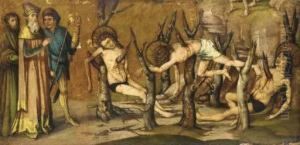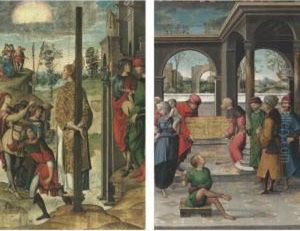Juan Rodriguez De Solis Paintings
Juan Díaz de Solís was a Spanish navigator and explorer in the early 16th century, born around 1470 in Lebrija, Seville, Spain. His early life is not well-documented, but by the time of his major voyages, he had become a seasoned navigator and had gained considerable experience in the Atlantic waters, navigating along the coast of Africa and to the Americas under the Spanish flag. His contributions to exploration were significant during the Age of Discovery, a period characterized by European exploration overseas through which new lands and trade routes were discovered.
In 1508, Solís was appointed as the pilot major of Spain, a position that made him the chief navigator of Spain, responsible for the training of pilots and the creation of nautical maps. This role underscored the trust and esteem that the Spanish crown placed in his expertise and experience. His most notable expedition took place in 1516, when he was commissioned by the Spanish King to find a new route to the Spice Islands, now part of Indonesia, by sailing westward from Spain to reach the Pacific Ocean. This mission was aimed at establishing a Spanish presence in the Moluccas (Spice Islands) without encroaching on Portuguese territories, as delineated by the Treaty of Tordesillas.
Juan Díaz de Solís embarked on this ambitious voyage with three ships, navigating along the coast of South America. His expedition led to the first European sighting of the Río de la Plata, a vast estuary located between what is now Argentina and Uruguay. Solís and his crew initially believed the estuary could be the sought-after passage to the Pacific Ocean and the Spice Islands. However, this hope was short-lived as they soon realized the true nature of the estuary.
Tragically, Solís' expedition met a grim end during this exploration of the Río de la Plata. In early 1516, while attempting to land and explore the region, Solís and several of his crew were attacked and killed by the indigenous Guaraní people. The exact circumstances of his death remain a subject of debate among historians, but it marked a premature end to his exploration efforts. Following his death, the remnants of his expedition managed to return to Spain, bringing with them the news of the discovery of the Río de la Plata, but also the tragic loss of their leader.
Juan Díaz de Solís' exploration of the South American coast and the discovery of the Río de la Plata were significant for several reasons. Although his primary mission to find a direct route to the Spice Islands was not achieved, his voyages contributed to the European knowledge of the South American continent. Moreover, the mapping and claims made by Solís and his crew paved the way for future Spanish explorations and settlements in the region, particularly in the territories that would later become Argentina and Uruguay. Despite the tragic end to his final voyage, Solís is remembered as a pioneering navigator whose efforts expanded the horizons of the known world at the time.


